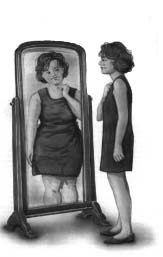Body Image and Silly Diets
by Dr. Rosemary Stanton,
Nutritionist
 The
dedication in my recent book, The Diet Dilemma
Explained states "for all who fear they are
too fat and are not, and for those who genuinely
are and have not known what to do about it".
Most women in our society fit into one of these
categories, and hopefully after reading this book,
many more would realise they fit into the first
group. The
dedication in my recent book, The Diet Dilemma
Explained states "for all who fear they are
too fat and are not, and for those who genuinely
are and have not known what to do about it".
Most women in our society fit into one of these
categories, and hopefully after reading this book,
many more would realise they fit into the first
group.
Excess
weight is more common now than ever before at
all ages and in both sexes. At the same time,
concern about excess weight has increased significantly
and has little relation to whether excess weight
actually exists. Many women now consider their
normal female body is too fat, even when objective
measurements would define it as perfectly normal.
We used to eat when we were hungry and stop when
we felt full. Many women now think constantly
about food, wanting it but striving to avoid it.
Eventually, they give in and eat and then feel
guilty about it.
Part
of the problem lies with poor self esteem, almost
certainly aided by constant hammering at women
to 'improve' some aspect of their bodies. The
'improvement' industry is now turning its attention
to teenage boys, convincing them that their size
and shape is not perfect either.
Let's
look more closely at body fat. Studies show an
increasing risk of health problems such as diabetes,
heart disease, high blood pressure and some cancers
if you have excess body fat. However, these problems
are only related to excess fat around the waist
and on the upper body - the so-called 'apple'
shape. Fat on the tummy, hips, bottom and thighs
- the typical female 'pear' shape is not a risk
for these common health problems.
The
main health hazard associated with lower body
fat is damage to self esteem from those who tyrannise
women by suggesting there is something wrong with
the basic female body shape. In modern Western
society, the ideal female is portrayed as slim-hipped
and long-legged, with full rounded breasts. It's
not a shape that comes naturally for most women
and because it is rare, it is considered highly
desirable. Problems arise when we treat anyone
who does not fit the rare shape as if they are
abnormal. In marketing terms, it makes for good
profits if you can pick on something that the
majority of people have, tell them it's a problem
and then offer them a remedy.
 Much
of the relentless drive to persuade normal-sized
women that they are faulty comes from the purveyors
of products such as pills, potions and diets.
The successful selling techniques were evident
recently with a pill that was supposed to remove
cellulite. Within one hour, the first shipment
of 50,000 boxes (at $59/box) sold out, netting
its marketers almost $3 million. From their second
shipment of 40,000 boxes, they took another $2,360,000.
There was no published proof that the product
worked and no biochemical reason why it could.
Women bought the product because they had been
led to believe that cellulite is ugly and abnormal. Much
of the relentless drive to persuade normal-sized
women that they are faulty comes from the purveyors
of products such as pills, potions and diets.
The successful selling techniques were evident
recently with a pill that was supposed to remove
cellulite. Within one hour, the first shipment
of 50,000 boxes (at $59/box) sold out, netting
its marketers almost $3 million. From their second
shipment of 40,000 boxes, they took another $2,360,000.
There was no published proof that the product
worked and no biochemical reason why it could.
Women bought the product because they had been
led to believe that cellulite is ugly and abnormal.
Some
companies selling 'cures' even refer to it as
"toxic waste trapped beneath the skin".
In fact, cellulite is a normal layer of fat which
serves as an energy reserve in case of famine
during pregnancy and lactation. In parts of the
body where the skin layer is thin and there isn't
a lot of firm muscle, the fats cells clump together
and give a slightly dimpled appearance. It is
not a health hazard and great artists like Rubens,
Renoir or Australia's Norman Lindsay honoured
it as evidence of female fertility.
Supermarkets
and Internet sites now sell a range of diet products
with ingredients which may include such as brindleberry
extract, chitosan, L-carnitine and other amino
acids, choline, lecithin, collagen, kelp, chromium
picolinate, pyruvate, horse chestnut extract,
inositol and a variety of herbs, enzymes and vitamins.
Properly-controlled trials have not shown any
of these products help with weight loss, in spite
of some very glowing testimonials from people
identified only as Mrs LW of Melbourne or Satisfied,
from South Australia.
There
are also dozens of silly diets. Most are aimed
at those wanting a quick fix. Very few discuss
whether the reader really needs to lose weight.
The latest diets are low in carbohydrate - or
'carbs'. Protein is often promoted as the answer
to every would-be slimmer's prayer and many put
no restriction on fats, although it is hard to
understand how anyone could eat much butter or
cream when everything you would normally put it
on is forbidden!
There
is no mystery to the fast weight loss you get
with these diets - it's due largely to a loss
of water. With a low carbohydrate intake, the
body uses its 600 grams or so of carbohydrate
stores, and also loses the 2 kilograms of water
stored with them. It then begins to break down
protein to form glucose so the brain and essential
organs can continue to function. The leftover
parts of the protein molecule must then be excreted
through the kidneys, and this takes more water
from the body. You lose weight, but not much fat.
The lost water eventually returns and the body
that was starved of carbohydrate stores up a bit
extra in case the cycle is repeated.
 Did
you like this article? Here's a WHOLE BOOK by
the same author! Did
you like this article? Here's a WHOLE BOOK by
the same author!  Complete
Book of Food and Nutrition Complete
Book of Food and Nutrition
For
more articles on health and lifestyle issues,
please visit Body
Talk Magazine.

|

 The
dedication in my recent book, The Diet Dilemma
Explained states "for all who fear they are
too fat and are not, and for those who genuinely
are and have not known what to do about it".
Most women in our society fit into one of these
categories, and hopefully after reading this book,
many more would realise they fit into the first
group.
The
dedication in my recent book, The Diet Dilemma
Explained states "for all who fear they are
too fat and are not, and for those who genuinely
are and have not known what to do about it".
Most women in our society fit into one of these
categories, and hopefully after reading this book,
many more would realise they fit into the first
group.  Much
of the relentless drive to persuade normal-sized
women that they are faulty comes from the purveyors
of products such as pills, potions and diets.
The successful selling techniques were evident
recently with a pill that was supposed to remove
cellulite. Within one hour, the first shipment
of 50,000 boxes (at $59/box) sold out, netting
its marketers almost $3 million. From their second
shipment of 40,000 boxes, they took another $2,360,000.
There was no published proof that the product
worked and no biochemical reason why it could.
Women bought the product because they had been
led to believe that cellulite is ugly and abnormal.
Much
of the relentless drive to persuade normal-sized
women that they are faulty comes from the purveyors
of products such as pills, potions and diets.
The successful selling techniques were evident
recently with a pill that was supposed to remove
cellulite. Within one hour, the first shipment
of 50,000 boxes (at $59/box) sold out, netting
its marketers almost $3 million. From their second
shipment of 40,000 boxes, they took another $2,360,000.
There was no published proof that the product
worked and no biochemical reason why it could.
Women bought the product because they had been
led to believe that cellulite is ugly and abnormal.
